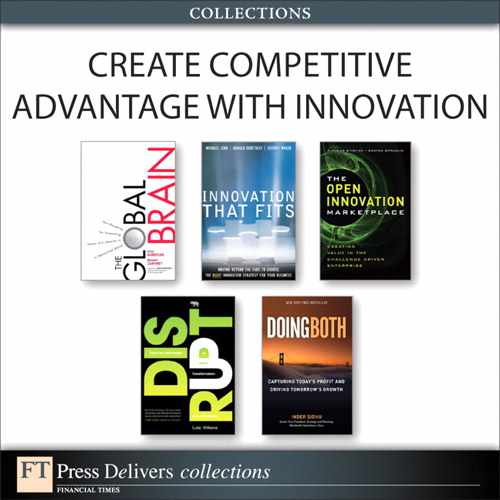Chapter 2. Understanding Network-Centric Innovation
The Human Genome project (HGP) is a classic example of the awesome innovative power of networked communities. The HGP was an international research initiative that aimed to identify and sequence the approximately 20,000 to 25,000 genes that make up the human DNA. The project was unique in that it brought together a large number of research and scientific organizations across the globe in a collaborative initiative. The HGP, begun in 1990, was completed in 2003, at least three years ahead of schedule.1
The HGP is remarkable not only from a scientific point of view, in that it produced a map of the human DNA, it is also remarkable in terms of how the innovation effort was organized. HGP showcased two distinct themes that underpin network-centric innovation. First, a network of contributors who pool resources and capabilities can produce extraordinary results. Second, the sociological perspective of knowledge creation—that is, the notion of “building on each other’s ideas” through interactions—is fundamental to contemporary innovation contexts, which often involve highly complex and diverse sets of knowledge.2
The confluence of these two themes is transforming the nature of innovation. On the one hand, businesses are becoming more networked in their operations. On the other hand, Open Source Software and other similar initiatives exemplify the benefits of “social” knowledge creation. In this chapter, we take a deeper look at these themes and trace the philosophical and historical roots of network-centric innovation.
Like any other new and emerging phenomenon, the evolution of network-centric innovation is also characterized by rapid speciation. Companies experiment by adopting different types of network-centric innovation models. As a result, we are seeing a wide range of approaches to network-centric innovation. We examine these varying “flavors” of network-centric innovation to highlight the richness and diversity of the emerging landscape. This landscape, while presenting many opportunities, also poses a difficult question for companies—which among these is the best approach? To answer this question, we structure the network-centric innovation landscape into a systematic framework in the chapters that follow.
The Historical and Philosophical Roots of Network-Centric Innovation
Modes of Production (of Ideas)
At its heart, network-centric innovation is an approach to organizing for the production of new ideas. As such, the philosophical roots of network-centric innovation can be traced to the literature on the alternate modes of production of goods.
Economists have long maintained that there are two primary modes of producing new ideas or new products: markets and hierarchies. Ronald Coase, in his classic work, The Nature of the Firm, set out the rationale for the existence of the firm (the “hierarchy” mode of production) using the concept of transaction costs. Transaction costs are costs associated with conducting a market transaction. They include the cost of identifying a market partner and the cost of defining and enforcing property and contract rights. Coase (and later, in a more rigorous fashion, Oliver Williamson) argued when the transaction costs increase beyond a certain level, it becomes more profitable to conduct and coordinate the production activities inside a firm instead of using a market-based mode of production. In other words, by considering the overall cost of production, which includes the market exchange cost or the organization cost, one can decide whether a market or a firm would be most appropriate. Until the Open Source Software communities came along, markets and firms were the two dominant modes of production.
However, the successful development of Linux and other Open Source Software products in the 1990s implied the existence of a third mode of production for new ideas or new products—one that was not just a hybrid of markets and firms. Yochai Benkler, a law professor at Yale University, wrote a series of articles suggesting that Open Source Software (and other similar open source communities) present a third model of production that he termed the commons-based peer production model. Using the same transaction cost logic, Benkler argued that when the “cost of organizing an activity on a peered basis is lower than the cost of using the market, and the cost of peering is lower than the cost of hierarchical organization” the commons-based peer model of production will emerge, as it did in the case of software.3
The commons-based peer production model is particularly relevant in contexts where the object of production is information-based (such as software, music, movies, and so on), and when the physical capital necessary for that production (for example, computers) is widely distributed, and the cost of peering is lowered through inexpensive communication facilities (for example, the Internet).
One such context is book publishing. For example, the publisher of this book, Prentice Hall, embarked on an innovative project that employs the principles of the commons-based peer production model to create a new book on business management. The book, We Are Smarter Than Me, involves collaboration among thousands of business professionals and scholars, including faculty, students, and alumni of the MIT Sloan School of Management and the Wharton School.4 The output from this collaborative effort will be published in book form in the fall of 2007 by Prentice Hall, with all contributors getting equal credit.
We summarize the key differences among the three modes of production in Table 2.1.
Table 2.1. The Three Modes of Production of Ideas
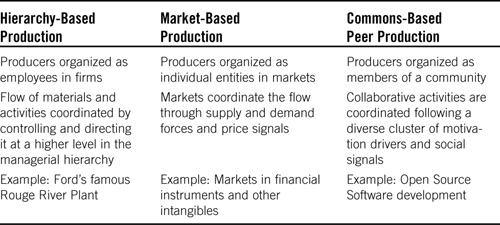
It is clear that markets, hierarchies, and commons form three alternate modes of production of innovation, too. The development of Windows by Microsoft is an example of innovation organized inside a firm (that is, using managerial hierarchies). Similarly, innovation can also be organized through open markets—companies routinely buy innovative startup firms to access innovative ideas and technologies. And finally, the development of Linux, Apache, and other Open Source Software products are examples of the commons model of organizing innovation.
The emerging models in the network-centric innovation landscape, however, reflect not just the market or the commons approach to innovation but instead the mix or the intersections of these three modes of production—for example, the mix of the commons-based model with the managerial hierarchy-based model, or the market-based model intersecting with the commons-based model. To understand the origins of such hybrid modes of production, we need to understand the history of network-centric innovation.
The History of Network-Centric Innovation
The real-world manifestation of network-centric innovation can be traced back to two distinct movements that took root in the 1990s: the Open Source movement (social knowledge creation) and the concept of business networks or ecosystems.
The Open Source Movement
The Open Source concept, in general, relates to the development and production of ideas, artifacts, and systems in a manner that provides free access to the end product’s sources and enables free distribution through appropriate licenses.5 It is based on the fundamental principle that users can be co-developers and that knowledge is created through “a synergistic interplay between individual contributions and social interactions.”6 While the essential philosophy behind open source existed in some form or the other in the 1980s (for example, the Free Software Foundation), the emergence of the Internet and the way it enables communities to come together and pursue collaborative development and production provided the Open Source movement its momentum in the early 1990s.
The software industry is the most prominent among the different fields and domains that the Open Source movement is evident. Open Source Software (OSS) can be defined simply as computer software whose source code is available to everybody for use, enhancement and modification, and distribution.7 Several types of OSS copyright licenses exist that vary in the type and extent of rights granted for using, altering, and/or distributing the software product. The Open Source Initiative (a non-profit entity formed in 1998 by OSS visionaries Eric Raymond and Bruce Perens) has assumed the role of promoting the Open Source Software movement by certifying products as open source products based on whether they are distributed under any of the alternate licensing schemes listed with the OSI.8 The number of such OSI-certified products has increased considerably over the past few years and runs into several hundreds now.9 The steady increase in the number of OS products indicates the overall health of this movement and its wider acceptance by the software business community.
The open source movement is now visible in several other domains, too. For example, the concept of open source intelligence (OSINT)—which relates to gathering information from open or public sources (such as, blogs, Web sites, and so on) and analyzing it to produce usable intelligence—has gained much prominence in recent years. Open source journalism (also referred to as citizen journalism) is another prime example. Other areas where the principles of the Open Source movement have started to take hold include pharmaceuticals or research and discovery of drugs (for example, the Tropical Disease Initiative), computer hardware (open source hardware), education (open source curriculum), and open source filmmaking.10
Business Ecosystems
The concept of business ecosystems derives its roots from the fields of biology and social systems. In an article published in the Harvard Business Review in 1993, James Moore described a business ecosystem as “an economic community supported by a foundation of interacting organizations ... the ‘organisms’ of the business world. The member organizations also include suppliers, lead producers, competitors, and other stakeholders. Over time, they co-evolve their capabilities and roles, and tend to align themselves with the directions set by one or more central companies.”11
A closely related concept is the alliance constellation. It describes a firm’s set of alliance partners who come together to form a network or constellation. In such an alliance constellation, member companies jointly pursue a number of strategic goals including linking markets, reducing operational costs, sharing risk, and combining complementary skills.12 A good example of an alliance constellation is the Star Alliance in the airline industry. Such groups enable member companies to compete and win in their markets by drawing on the resources and capabilities of their network of partners.
The key contribution of the business ecosystem and alliance constellation concepts has been to force companies to broaden their perspectives while devising their corporate and business strategies. More specifically, the application of the ecology perspective helped large companies such as Wal-Mart, Intel, Microsoft, and SAP to realize the importance of building robust business ecosystems to further their own future prospects. The ecosystem perspective also highlighted the changed nature of competition—from competition among individual companies to competition among business ecosystems or alliance constellations.13
Although business ecosystems and alliance constellations are now familiar terms to most managers, these concepts have mostly been applied to analyze and devise market and operational strategies. However, these concepts also serve to illustrate how companies can champion and orchestrate innovation activities in their industries by establishing and leading a network of partners. For example, Intel’s dominance in the semiconductor industry in the 1980s and 1990s can be explained to a great extent by its ability to establish, nurture, and lead a network of partners who collectively contribute to and enhance the value of Intel’s technology platform.14 More recently, the battle for High-Definition DVD players between the Sony-led Blu-Ray consortium and the Toshiba-led HD-DVD consortium will also be won or lost based on the share of the Global Brain that Sony or Toshiba can attract to their ecosystem, including content providers, hardware manufacturers, and retailers.
The Confluence of Open Source Innovation and Business Ecosystems
In recent years, the boundaries between these two movements—open source communities and business networks (or ecosystems)—have begun to blur. On the one hand, companies are seeking out open source communities and other communities of creation (for example, customer communities and inventor communities) as partners in innovation. On the other hand, innovations that have emerged from the open source communities are transitioning into the commercial world (for example, commercial open source). So the neat distinction between “purely open” and “purely proprietary” forms of organizing for innovation is giving way to a more complex and nuanced landscape. A wide variety of networks, players, and roles are emerging: business ecosystems, alliance constellations, open source communities, inventor communities, customer communities, expert communities, and other such communities of creation.
The concept of network-centric innovation embraces these different types of innovation networks and players. But it does more. It also captures the unique approaches to organizing innovation that arise from the combinations of different types of networks and the interactions of companies with different types of innovation networks.
These new approaches to organizing innovation are also characterized by the hybrid modes of production mentioned earlier. In other words, markets, hierarchies, and commons collide in the network-centric innovation landscape and give rise to hybrid modes of production of innovation that underlie the alternate approaches to network-centric innovation. We describe these hybrid modes of production in more detail in subsequent chapters in terms of archetypes or models of network-centric innovation.
With this understanding of the historical and philosophical roots of network-centric innovation, we now turn to the core principles that underlie the different approaches to network-centric innovation.
Principles of Network-Centric Innovation
The concept of network-centric innovation has four defining principles: shared goals, shared “world-view,” social knowledge creation, and an architecture of participation. These principles are consistent with the historical roots of network-centric innovation in the Open Source movement and business ecosystems. We briefly describe these four principles and summarize them in Table 2.2. Later in the book, we return to these principles as we describe the different models of network-centric innovation.
Table 2.2. Principles of Network-Centric Innovation
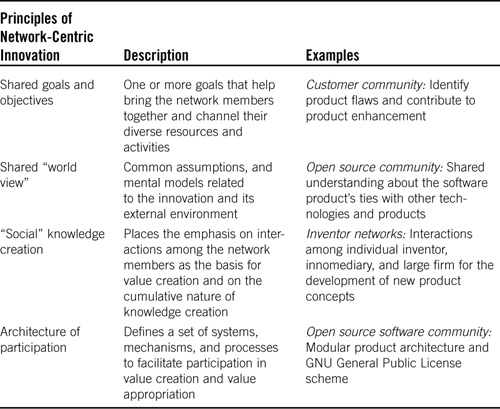
Shared Goals and Objectives
For a set of players to come together to contribute to an innovation initiative, it is essential that they have a common set of goals and objectives. These shared goals and objectives act as the glue that keeps the community together—giving direction, enabling coordination of activities, and facilitating the development of a common set of norms and values. For example, the shared goal of a community of customers might relate to providing innovative ideas and inputs to the product developer (vendor) to improve the quality and value of the product features. These shared goals and objectives might develop in different ways—in some networks, a central entity might devise and promote those goals, whereas in other networks, the shared goals might emerge through interactions among the players.
Shared Awareness and “World View”
The network members also need to share a common “world-view” or shared awareness of the external environment. These might include business assumptions, evaluation methods, and frameworks. A shared awareness is critical for the network to capitalize on the synergies among the diverse set of expertise and capabilities in the network. For example, in the case of an Open Source Software development community, the shared world-view might include knowledge about competing and complementary products and technologies, and how the products being developed should relate to or integrate with existing products and technologies.
The world-view in an innovation network is dynamic. It continually evolves in response to changes in the environment. The connectedness of the network facilitates rapid information sharing that in turn facilitates the maintenance of a shared awareness of the environment in which the network operates.
“Social” Knowledge Creation
New knowledge is increasingly created through interactions among the different types of players or members in a network. For example, open source communities rely on the theme that all users can be co-developers and that innovative concepts evolve from building on one another’s ideas or contributions. Such a concept of “social” knowledge creation is evident in customer communities, too, where dialogues among peer customers become the context for product improvement ideas and new product concepts.
Although we use the term “social” here, it is not necessarily limited to open source communities. Instead, this principle reflects the collaborative and cumulative aspect of knowledge creation that is evident in many other types of innovation networks. Even in a market-based model, innovative ideas evolve through interactions among the network members. For example, even in inventor networks, interactions among the individual inventor, the innovation intermediary, and the larger firm provide the context for new product ideas to bubble up and get transformed into commercially feasible product concepts. The key idea is simple—knowledge is created and enhanced socially as people build on each others’ contributions, and a social or network infrastructure needs to be in place to facilitate social knowledge creation.
Architecture of Participation
The fourth principle of network-centric innovation relates to the way innovation work is distributed among the network participants and the way “rights” from the innovation are shared by the participants. This principle goes beyond just identifying the core and non-core tasks as in outsourcing innovation. Instead, it relates to the development of an architecture of participation—a term coined by Tim O’Reilly15—that provides a road map for the different players to come together to innovate. The architecture of participation provides the mechanisms and methods for the contributions of participants to be coordinated, integrated, and synchronized in a coherent manner.
Two key aspects of such architecture of participation are the modularity of the innovation system and the granularity (size or scale) of the innovation tasks. Whereas modularity enables distributing and coordinating the innovation processes, granularity assures that a diverse set of members (that is, members with diverse types of resources, capabilities, and time commitments) can contribute to the innovation. The architecture of participation also has to define the means by which the participants will be “rewarded” for their contributions. This reward could range from establishing different types of incentives that drive participation in certain networks (for example, customer communities) to new value appropriation methods for sharing the innovation proceeds among the participants (for example, patent pools, Creative Commons license, and so on).
The Different “Flavors” of Network-Centric Innovation
If we look at the history of automobiles, it becomes clear that the period from the mid-to-late 1800s was the “era of ferment” in the industry—the stage before one or more dominant designs emerge.16 Such an era of ferment is characterized by prolific experimentation. In the automobile industry, inventors experimented with different types of fuels (wood, alcohol, gasoline, and electricity), different types of engines, different types of body structure, and so on. Some of these inventions worked, others did not. But all of them contributed to the evolution of the design that became the dominant model in the early 1900s.
Similarly, considerable experimentation is going on in the network-centric innovation landscape. The new models and approaches that are emerging are characterized by a wide range of structural arrangements, innovation activities, and outcomes. Let’s look at some of these forms of network-centric innovation, with an example of a company that is pursuing each form.
Open Source Software Communities and IBM
In the early 1990s, at a time when the open source phenomenon was still in its infancy, IBM made key changes to align itself more closely with the emerging Open Source Software movement. An excellent example of that shift was the 1996 Atlanta Olympics where IBM was responsible for building and deploying the first Olympics Web site—the results from all the competitions were available in real-time on the IBM-designed Web site. When it came to choosing the server platform for the Web site, IBM chose Apache, an open source solution, despite the fact that IBM had a competing proprietary product for serving Web sites. In recent years, IBM has made conscious decisions to promote and align its own strategies to leverage the power of the Open Source Software communities—in markets ranging from Web servers and operating systems to scripting languages and development tools.
IBM’s approach to open source is not a philanthropic approach; instead, it is a considered business decision. In the words of Irving Wladawsky-Berger, IBM’s former Technical Vice-President, it is a decision made “after considerable analysis of the technology and market trends, the overall quality and commitment of the community...and the quality of its offerings.”17
In working with the open source communities, IBM is pursuing a network-centric innovation strategy that involves itself with a vast global network of software developers who make different types of innovative contributions. IBM does not set out the innovation agenda for the open source community nor does it directly benefit from the products developed by the community. Instead, IBM plays the role of a sponsor or patron, whose interest is to sustain the overall energy and health of the open source movement. Of course, as Dr. Wladawsky-Berger notes, it is a “business decision”—IBM does indirectly benefit from the offerings of the open source communities. For example, IBM’s revenues from Linux-related services have increased exponentially from 2001 when it started investing in an open source–based business model. By 2004, IBM realized more than $2 billion in revenues from Open Source–related businesses.18
Customer Communities and Ducati
Ducati’s involvement and relationship with its innovative customer community provides another flavor of network-centric innovation strategy. Ducati Motor is a world-renowned motorcycle company based in Italy. The motorcycle is a lifestyle-intensive product and as such most successful motorcycle companies focus on building extensive relationships with their customers to foster a sense of community that complements the actual product.
However, Ducati views its relationship with its customer community not just as a customer relationship management initiative but as part of its innovation strategy—Ducati considers its customers as partners in innovation. In early 2000, it set up a separate Web division to coordinate its Internet-based customer collaboration initiatives.19 Ducati employs different types of virtual customer environments (all part of its Web site) to involve customers in both the front-end and the back-end of the innovation process (see Figure 2.1). Ducati’s customers have deep technical knowledge and some of the customers even come up with complex technical and mechanical design improvement ideas—ideas that can be (and have been) translated into real product features. In addition, at the back-end of product development, customers also participate in product testing through the virtual customer environment.
Figure 2.1. Ducati’s Customer Community Initiative
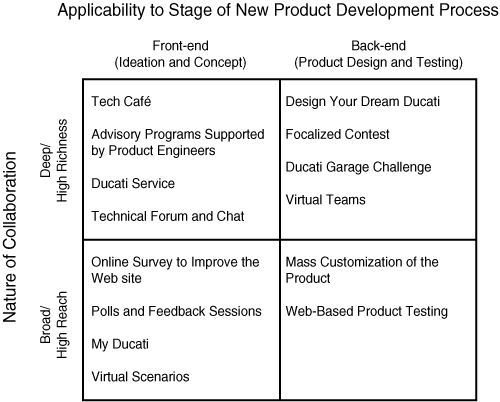
From Mohanbir Sawhney, Gianmario Verona, Emanuela Prandelli, “COLLABORATING TO CREATE: THE INTERNET AS A PLATFORM FOR CUSTOMER ENGAGEMENT IN PRODUCT INNOVATION”; The Journal of Interactive Marketing, p. 8, Vol. 19, No. 4, Autumn 2005. © 2005 Wiley Periodicals, Inc. and Direct Marketing Educational Foundation, Inc. Reprinted by permission.
Ducati thus pursues a network-centric innovation strategy wherein it hosts, facilitates, and promotes an active customer community, and coordinates the innovation activities and resources (customer ideas and expertise) to enhance its innovation agenda.
Inventor Networks and Staples
Staples Inc., the leading office supplies company, has marketed private-label, low-price generic products with Staple’s name on the package from the 1990s onwards. This strategy has served them well in the past—revenue contributions from Staples-branded products accounted for 18% of its total sales of $16 billion in 2005.20 However, with more competition in the office supplies market, Staples has started changing its strategy in the last few years. But Staples does not want to limit itself to low-cost, me-too products. Instead, it wants to pursue the development of more innovative products—products that will position the firm as an innovator with national brand recognition.
How can a company without a vast internal product development group pursue such an ambitious innovation agenda? Staples believes that innovative ideas are out there in the marketplace. As Jevin Eagle, the Senior Vice President of Staples brands, notes, “Our job is to scour the world for ideas.”21 To hunt for those ideas, Staples holds an “idea” contest called InventionQuest—individual inventors are invited to submit their ideas to Staples, and winning ideas are commercialized by Staples under Staples brand name with the inventor receiving 8% of revenues of royalty (see Figure 2.2). Staples also employs third parties such as PDG LLC., to reach out into the inventor community and bring back promising ideas to Staples for potential commercialization.
Figure 2.2. Staples and the inventor network (from The Wall Street Journal Online, July 13, 2006)

© Staples, Inc. Reprinted by permission.
In pursuing this form of network-centric innovation, Staples sources ideas from the large inventor community, significantly increasing its potential to generate valuable ideas. In a recent contest, about 10,000 individual inventors submitted ideas. Ron Sargent, Staples’ CEO, believes that this innovation strategy—centered on external inventor networks—will form its main weapon to fuel Staples’ revenue growth in the future. It has already enabled Staples to surpass its main competitor, Office Depot, in revenues and become the top retailer in the office superstore market.
Developer Networks and Salesforce.com
Yet another flavor of network-centric innovation is the creation of an ecosystem of developers who can innovate on a common platform. Consider how Salesforce.com, a leading vendor of customer relationship management (CRM) solutions, has leveraged the power of independent software developers. Founded in 1999 by former Oracle executive, Marc Benoiff, Salesforce.com offers CRM software that enables businesses to track and analyze all of their interactions with customers in real-time. The unique aspect of Salesforce.com is that it provides this solution exclusively “on demand”—in other words, client firms access the application software as a service through a Web browser over the Internet.
More recently, Salesforce.com has created a unique approach to tap into the creativity of independent software developers to enhance its software offerings. In 2005, it launched AppExchange, a forum for external developers to create add-on applications that can link into or integrate with the main Salesforce.com system. More than 600 such add-on applications are available, ranging from e-mail marketing tools to sales analysis tools to finance tools.
Unlike other large software firms such as Microsoft and Oracle, Salesforce.com does not just provide a forum for external developers to develop applications on the platform. Instead, it actively participates in it by marketing the tools offered on the AppExchange to its clients and even conducts the sales transactions and appropriates the proceeds back to the external developers. In many instances, it also provides guidance and direction for innovation efforts of its software partners by channeling potential application ideas from clients to the external developers. The company also plays the role of a community sponsor and promoter by facilitating interactions among the developers as well as by providing the infrastructure for writing and sharing customized solutions.
Thus, in establishing AppExchange, Salesforce.com pursued a network-centric innovation strategy wherein its primary role was to provide the broad vision and the basis (that is, the technology platform) for the innovation and to orchestrate the activities and interactions among its global partners. What does Salesforce.com gain from doing this? Two things—first, the tools and solutions offered through the AppExchange clearly add value to the basic software application that Salesforce.com offers to its clients. Second and more importantly, the community of developers in AppExchange enhances the overall innovation reach and range of Salesforce.com. The company does not offer the full and integrated range of enterprise solutions that firms such as Oracle and SAP offer. But through AppExchange, Salesforce.com can now extend its services to other and more profitable applications areas, such as human resources and finance, as well as to markets such as the healthcare industry. By following a network-centric innovation strategy, Salesforce.com is able to derive innovation gains that are orders of magnitude higher than would be possible with its limited resources.
Electronic R&D Marketplaces and 3M
In recent years, a number of electronic R&D networks like InnoCentive (www.innocentive.com) and NineSigma (www.ninesigma.com) have sprung up as another interesting flavor of a network-centric innovation mechanism. These networks play a matchmaking role between “seekers” of solutions to scientific problems (typically large R&D-intensive corporations) and “solvers” of these problems (typically individual scientists or small research laboratories spread across the world). Large companies often have very specific technical issues and R&D problems that they are unable to solve internally at an acceptable cost or time frame. When potential solutions from inside the company dry up, they use electronic R&D networks as a vehicle to look outside for those answers by tapping into the global talent pool of scientists and engineers.
Consider the R&D problem that the large industrial manufacturer 3M recently faced—it wanted an adhesive system that would be capable of durably adhering a polyester film to an oil-laden natural stone or fired clay surface.22 The adhesive needed to be resistant to oils, cleaning chemicals, high pH detergents, and standing water. The adhesive system also needed to remain bonded to the oil-soaked surface for at least 18 months. Unable to find an appropriate internal solution to this problem, 3M turned to NineSigma, an electronic R&D marketplace. NineSigma hosts a global community of scientists and technologists with deep expertise in different fields. NineSigma prepared a Request for Proposal (RFP) based on 3M’s requirements. Thousands of relevant scientists viewed the RFP and five potential solutions were offered through the NineSigma Web site. 3M evaluated the solutions and selected one as the most appropriate.
In this network-centric innovation scenario, the relevant part of the Global Brain consists of a global pool of scientists and technologists with 3M playing the role of a solution seeker and NineSigma playing the role of a marketplace operator.
Different Networks, Different Approaches, Different Outcomes
The earlier examples portray the different forms that network-centric innovation can assume—different types of networks or different types of the Global Brain involved, different types of roles for companies to play, different types of relationships among network members, and different types of innovation outcomes or returns (see Table 2.3).
Table 2.3. The Different Flavors of Network-Centric Innovation
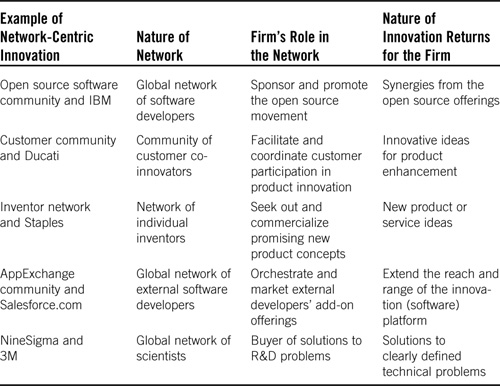
These differences hold important implications for companies pursing the network-centric innovation strategy. Let us consider some of these implications.
Implications for Reach and Range of Innovation
The different flavors of network-centric innovation offer very different levels of the firm’s reach into the Global Brain and the range of innovative ideas it can source from it. For example, Ducati has direct ties with its network of customer co-innovators whereas both 3M and Staples interact with much larger networks (comprised of scientists and individual inventors, respectively) through intermediary organizations.
Similarly, the range of innovative ideas also differs in the preceding examples. In the case of 3M, the focus was on a niche technical problem that needed to be solved. The nature of the problem space was clearly defined by 3M—in other words, there were few uncertainties regarding what the solution should achieve. In the case of Staples, it was a much more ambiguous innovation space. All that Staples had in view was innovative product concepts that would align well with its existing brand and channel. On the other hand, Salesforce.com had defined the basic innovation platform and the broad design parameters (that is, its main CRM software application) and the network partners were responsible for coming up with innovative product designs or add-ons that adhered to these broad parameters and extended the value of the platform.
Thus, several important questions can be posed: Where are the innovative ideas situated? What type of network should the firm “connect to”? What is the company’s reach into that network? And, what is the range of innovation that can be sourced and pursued collaboratively?
Implications for Organizational Capabilities
It is also evident that companies play different roles or participate in different types of innovation activities in network-centric innovation. They also have different types of relationships with the members of the network. These different roles and relationships imply the need for different types of organizational capabilities.
For example, whereas Salesforce.com has to provide leadership for its network of global partners, 3M plays the role of an innovation seeker and leverages the expertise available in the network of scientists. In contrast, IBM seeks to promote and champion the open source software movement and not overtly coordinate the software development activities. Similarly, consider the relational capabilities. The capabilities needed by Salesforce.com to interact with a set of global partners are different from those needed by Staples or Ducati to interact with a larger network of inventors (or customers, as the case may be).
In sum, different types of players in network-centric innovation require different types of capabilities. Understanding the nature of the role your company plans to play in network-centric innovation is important to figure out the nature of organizational capabilities and competencies that need to be developed.
Implications for Innovation Risks and Returns
The different examples also imply different types of risks and returns from the resulting innovation. For example, certain approaches seem to be designed to reduce the business, market, or technological risk assumed by a company. Consider Salesforce.com’s initiative. By getting external software developers to invest capital into developing complementary products and committing to the basic software platform, the company is able to share some of the innovation risk with its partners. On the other hand, some other approaches are designed to seek out really creative and new concepts—for example, Staples takes relatively “raw” ideas from the inventor network to commercialize and in doing so it trades-off the higher market risk for a more innovative product portfolio.
Thus, clearly, different forms of network-centric innovation imply different types of innovation risks and returns and pose some interesting questions for a company. What types of returns is it expecting from collaborative innovation? What is its risk threshold? Or, what types of risks is the company willing to assume?
Bringing a Method to the Madness
As evident from our discussion in this chapter, the varied approaches to network-centric innovation imply different opportunities with different implications. Naturally, the question then is, how should a company go about deciding what is the most appropriate network-centric innovation opportunity?
To answer this question, firms need to go beyond simply trying out different approaches and seeing what works, or copying what works for other companies. Instead, we recommend a more systematic approach that starts with a good understanding of the broad structure of network-centric innovation opportunities. With this knowledge in hand, managers can then narrow their focus to select a place in the landscape that is most relevant for the firm’s innovation context.
What do we mean by a company’s “innovation context”? The context includes the industry, technology, market, and internal organizational characteristics that together define the frame within which firms define and pursue their innovation agenda.
For example, consider technology and market-related attributes. How dynamic are the company’s core product technologies? How diverse are the product and technology knowledgebase? What is the nature of the customer base? Are complex and expensive infrastructure required for ideation in the industry? How capital-intensive is (product) commercialization? Similarly, consider organizational attributes. What is the nature of innovation that the organization is hoping to pursue collaboratively? What is the existing innovation infrastructure of the company? What is the collaboration experience of the company? What type of relational skills has it developed? What type of innovative contributions is the company expecting from outside? What type of value appropriation mechanisms and “property rights” systems is it comfortable with?
The answers to these and other similar contextual questions will indicate what type of innovation network would be most appropriate for the company to participate in, what types of roles the company can play in it, what types of capabilities it should develop for those roles, and more importantly, how the returns from those collaborative innovation activities will contribute toward the company’s goals and objectives.
However, before we start looking at the company’s innovation context, we need to develop a deeper understanding of the broad structure of the network-centric innovation landscape. In the next chapter, we do just that by defining the four fundamental models or archetypes of network-centric innovation.
